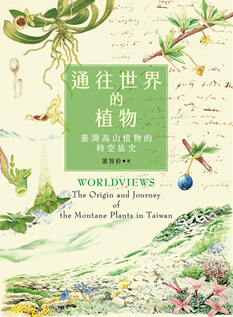Brendan Yu
游旨价
游旨价
Brendan Yu grew up in the eastern exurbs of Taichung City, closer to the mountains than the coast. He holds a Ph. D. from the School of Forestry and Resource Conservation at National Taiwan University. He has trekked all around Taiwan and visited many sites around the world to collect plants, with a particular interest in montane plants and the origin of alpine plant diversity. He has been a visiting scholar at Brown University and National Museum of Nature and Science in Tokyo with financial support from Taiwan’s Ministry of Science and Technology. He won the Best Dissertation Prize from the Taiwan Society of Plant Systematics, and the Dr. Peng Ching-I Memorial Prize.
Works

Openbook Award of 2020!
In Worldviews: The Origins and Odysseys of Taiwan’s Montane Plants, Taiwan’s mountains are a Noah’s Ark of biodiversity and a meeting place of montane plants. These montane plants are the main characters in an international drama of biogeography, the branch of the natural sciences that explains the distribution of life on earth. By relating the backstories of each of these characters, this book will take you on a journey of exploration into the distant past and around the world.
◎Why is Taiwan home to the world’s only rival to California’s giant sequoia (Sequoiadendron giganteum)?
◎Why does the closest living relative to Taiwan’s only extant endemic genus Sinopanax, a small evergreen tree, live in tropical America?
◎How did the South American herb Chaerophyllum involucratum cross the equator and the Pacific and end up thriving in alpine Taiwan?
In attempting answers to these questions, this book is not just a natural history of Taiwan’s montane plants. Each high mountain herb or tree discussed herein is both a crystallization of a unique transnational history and a microcosm of global biogeography. Adapting the first two lines of William Blake’s poem “Songs of Innocence,” Worldviews lets you see the World in a Wild Flower.
★Taiwan’s montane plants will be your guides on a journey of exploration of the ties that have linked Taiwan to the world over millions of years.
★Through the eyes of a biogeographer, you will read a natural epic in which Taiwan’s montane plants have played pivotal parts.
★The island of Taiwan takes center stage, but the stage is capacious, including the evolutionary history not just of East Asia but of the entire world, giving the book breadth and depth.
The natural history of Taiwan’s montane plants can be traced back tens of millions of years to far-flung realms: to the Himalaya in the east, to Siberia in the north, and to Tasmania in the south. But Taiwan is a particularly interesting setting in the story of botanical evolution for two reasons. First, it happens to be the eastern edge of the range of Himalayan plants and the southern extreme of temperate zone flora. It is also a way station for a number of plants from south of the equator. Second, Taiwan is an island, a place where one would expect endemic species to evolve, including plant species. Worldviews also explains the diversity of life on Taiwan in terms of a different kind of island: each of Taiwan’s high mountains – there are two hundred mountains over three thousand meters in the Central Mountain Range – is an evolutionary island. Orogeny – mountain formation – in Taiwan has isolated plant travelers and forced them to settle down. In the six million years since the formation of the island of Taiwan, they have evolved into numerous new species. For instance, the spiky barberry demonstrates the greatest genetic variation of any of the plants that grow on Taiwan’s tallest mountains, with thirteen endemic species. Little loved by mountain climbers, it excites admiration among contemporary botanists.
Taiwan’s montane plants have inspired awe in scientists for over a century, starting with the Japanese father of Taiwanese plant taxonomy, Bunzō Hayata. In 1911, in his Materials For a Flora of Formosa, Hayata wrote that a mysterious little herb, Chaerophyllum involucratum, took his breath away, because it reminded him of a plant in Australia that turned out to be its closest living relative. In 1916, out of the same profound appreciation, Ernest Henry Wilson, who is known to posterity as the Chinese Wilson because of his famous travels in China but who also paid an important visit to Taiwan, wrote: “Formosa is indeed the ‘Pearl of the Orient’ and her crowning glory are the magnificent forests of ever-green Lauraceae and Fagaceae, the gigantic Chamaecyparis and the lofty Taiwanias which clothe her steep and rugged mountains.” Taiwania is the tallest tree in East Asia, while the “gigantic” Taiwan red cypress, known as the “divine tree” throughout East Asia, is the stoutest, and the world’s only rival to California’s giant sequoia. Although Wilson’s mighty conifers illustrate the connections between Taiwanese and Japanese flora, it is a species like Hayata’s little herb that Charles Darwin thought might shed light on what he referred to as the “abominable mystery” of angiosperm diversity, because of its antipodean origin. Wherever they originated, and however large they are, the montane plants that have gathered in Taiwan have borne witness to the wonder of evolution. Each of them is a living memorial of an epochal biogeographical journey.
This book puts Taiwan’s montane plants in biogeographical, not national, context. Plant scientists cannot respect national borders any more than plants do. Naturalists like Hayata and Wilson have been amazed to encounter plants that bear an uncanny resemblance to those they grew up appreciating. By appreciating the origins of Taiwan’s montane plants, we, too, can understand the natural history of plants not in terms of national borders but in terms of biogeographical boundaries and the ways in which plants have crossed them, spinning the endless web of life.